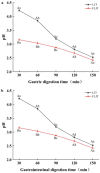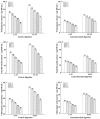Impact of fermentation on the processing and digestion characteristics of honeysuckle polyphenols by Lactobacillus acidophilus
- PMID: 40386218
- PMCID: PMC12083013
- DOI: 10.3389/fnut.2025.1570648
Impact of fermentation on the processing and digestion characteristics of honeysuckle polyphenols by Lactobacillus acidophilus
Abstract
The technology and digestive characteristics of honeysuckle beverages fermented by Lactobacillus acidophilus were researched, the digestive characteristics were evaluated by simulating the gastrointestinal digestive system in vitro. The optimum conditions were as follows: fermentation temperature, 35°C; fermentation time, 19 h; and inoculation amount, 3%. Fermented honeysuckle beverages had greater antioxidant and α-glucosidase inhibition capacities than unfermented beverages after digestion. The bioavailabilities of total phenol, total flavonoids and chlorogenic acid in fermented honeysuckle liquid were 29.72, 21.80, and 36.93%, respectively, whereas those in unfermented honeysuckle liquid were 22.03, 17.28, and 25.67%, respectively. The pH of the fermented honeysuckle beverage remained relatively stable during storage at 4°C, with no significant change (p > 0.05). The number of viable bacteria decreased from 9.79 lg CFU/mL to 8.31 lg CFU/mL, and the sensory score and color decreased. This study provides a reference basis for the development of honeysuckle products and specific functional probiotic products.
Keywords: Lactobacillus acidophilus; digestion; fermentation; honeysuckle; processing.
Copyright © 2025 Dong, Shi, Zhang, Deng, Ge and Li.
Conflict of interest statement
The authors declare that the research was conducted in the absence of any commercial or financial relationships that could be construed as a potential conflict of interest.
Figures









References
-
- Kong DX, Li YQ, Bai M, Deng YL, Liang GX, Wu H. A comparative study of the dynamic accumulation of polyphenol components and the changes in their antioxidant activities in diploid and tetraploid Lonicera japonica. Plant Physiol Biochem. (2017) 112:87–96. doi: 10.1016/j.plaphy.2016.12.027, PMID: - DOI - PubMed
LinkOut - more resources
Full Text Sources

